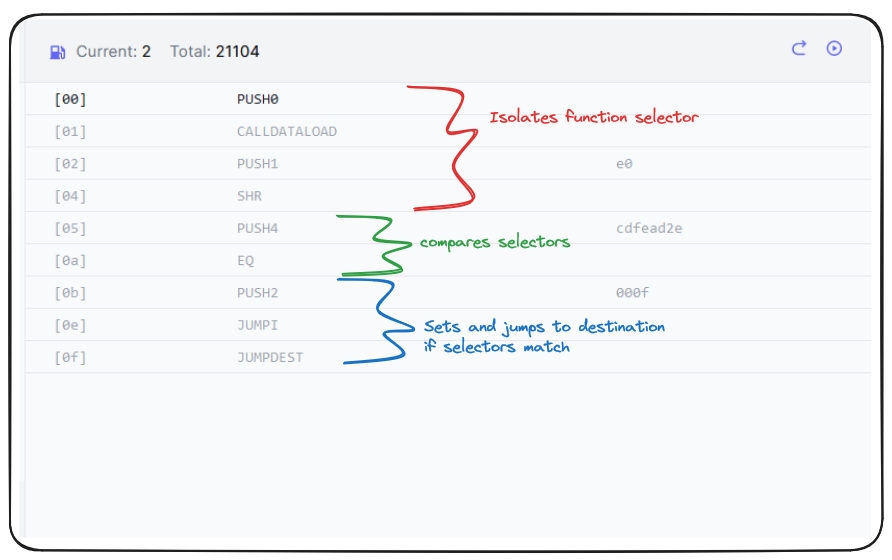5/5
_Follow along with this video:_ --- We're going to take a look at how this function in the [**evm.codes playground**](https://www.evm.codes/playground), and there's actually a convenient method, build into Huff, that allows us to retrieve the runtime bytecode of our compiled contract! ``` huffc src/horseStoreV1/HorseStore.huff --bin-runtime 5f3560e01c63cdfead2e1461000f575b ``` Paste the returned runtime bytecode into the evm.codes playground and let's step through what's happening with our contract.  By adding the runtime bytecode to the playground, we're presented with almost exactly what we wrote in Huff, converted to pure opcodes. Something that's going to stand out is the `JUMPDEST` code. To understand this opcode, let's take one step back. In the previous lesson we'd set `updateJump` as a pointer to our program counter of `SET_NUMBER_OF_HORSES()`. This is only partially true. When a `JUMP` or `JUMPI` opcode is executed, it requires a stack input of a `valid jump destination`. Huff's syntax allows us to define `updateJump` as a new `valid jump destination` before our `JUMPI` operation is executed. ```js updateJump: SET_NUMBER_OF_HORSES(); // sets the compiled location of the SET_NUMBER_OF_HORSES macro as a valid jump destination. ``` So, looking again at our playground: - Op Codes 1-4 - isolating `function selector` from received `calldata` - PUSH4 - Pushes our known `function selector` to the stack - EQ - Compares our isolated `function selector` to our known selector and returns 0/1 - PUSH2 - Adds our jump destination to the stack - JUMPI - Jumps to our destination if the value returned by EQ is anything other than 0 - JUMPDEST - An empty stack at our jump destination  Currently of course, nothing is going to happen after we jump to our new destination. We haven't added any logic to our macro yet. I encourage you to experiment in the playground before moving on. What's left on our stack after stepping through the code? What happens if we provide calldata that doesn't start with our expected `function selector`? Answer these questions, and I'll see you in the next lesson!
Follow along with this video:
We're going to take a look at how this function in the evm.codes playground, and there's actually a convenient method, build into Huff, that allows us to retrieve the runtime bytecode of our compiled contract!
Paste the returned runtime bytecode into the evm.codes playground and let's step through what's happening with our contract.

By adding the runtime bytecode to the playground, we're presented with almost exactly what we wrote in Huff, converted to pure opcodes. Something that's going to stand out is the JUMPDEST code. To understand this opcode, let's take one step back.
In the previous lesson we'd set updateJump as a pointer to our program counter of SET_NUMBER_OF_HORSES(). This is only partially true. When a JUMP or JUMPI opcode is executed, it requires a stack input of a valid jump destination. Huff's syntax allows us to define updateJump as a new valid jump destination before our JUMPI operation is executed.
So, looking again at our playground:
Op Codes 1-4 - isolating
function selectorfrom receivedcalldataPUSH4 - Pushes our known
function selectorto the stackEQ - Compares our isolated
function selectorto our known selector and returns 0/1PUSH2 - Adds our jump destination to the stack
JUMPI - Jumps to our destination if the value returned by EQ is anything other than 0
JUMPDEST - An empty stack at our jump destination

Currently of course, nothing is going to happen after we jump to our new destination. We haven't added any logic to our macro yet. I encourage you to experiment in the playground before moving on.
What's left on our stack after stepping through the code?
What happens if we provide calldata that doesn't start with our expected function selector?
Answer these questions, and I'll see you in the next lesson!
JUMPDEST
A detailed guide to the jumpdest opcode - This lesson dives into the jumpdest opcode, its functionality, and how it's used in conjunction with jump and jumpi. The lesson also illustrates real-world application by compiling and running a Huff contract.
Previous lesson
Previous
Next lesson
Next
Course Overview
About the course
What you'll learn
Assembly
Writing smart contracts using Huff and Yul
Ethereum Virtual Machine OPCodes
Formal verification testing
Smart contract invariant testing
Halmos, Certora, Kontrol
Course Description
Who is this course for?
- Smart contract security researchers
- Advanced Smart contract engineers
- Chief Security Officiers
- Security professionals
Potential Careers
Security researcher
$49,999 - $120,000 (avg. salary)
Smart Contract Auditor
$100,000 - $200,000 (avg. salary)
Meet your instructors
Guest lecturers:
Last updated on August 11, 2025
Duration: 30min
Duration: 4h 38min
Duration: 3h 57min
Duration: 1h 56min
Course Overview
About the course
What you'll learn
Assembly
Writing smart contracts using Huff and Yul
Ethereum Virtual Machine OPCodes
Formal verification testing
Smart contract invariant testing
Halmos, Certora, Kontrol
Course Description
Who is this course for?
- Smart contract security researchers
- Advanced Smart contract engineers
- Chief Security Officiers
- Security professionals
Potential Careers
Security researcher
$49,999 - $120,000 (avg. salary)
Smart Contract Auditor
$100,000 - $200,000 (avg. salary)
Meet your instructors
Guest lecturers:
Last updated on August 11, 2025
